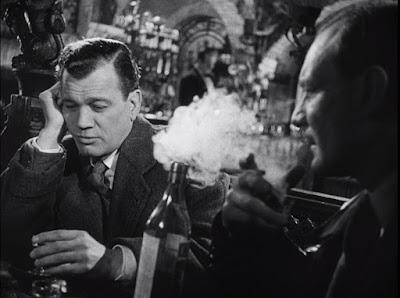 "The cuckoo clock. So long, Holly."
"The cuckoo clock. So long, Holly."Everyone remembers Orson Welles' speech about cuckoo clocks, jaunty and murderous at once. And Anton Karas' zither music, plucking minor keys around our expectations. Then there's director Carol Reed's vertiginous canted angles and the way they bevel Robert Krasker's rich, deep black-and-white cinematography. The atmospheric rubble and melancholy damp of war-smashed Vienna. That moment when the story turns on the cat that "liked only Harry." Beautiful and haunted Alida Valli's long final walk away from both the cemetery and the happy ending imagined by Joseph Cotten's sadder-but-no-wiser pulp novelist Holly Martins. Graham Greene's script that knows precisely when to light its fuses. All that glittering, quotable dialogue.
In The Third Man, from 1949, Martins is a "scribbler" of hack Westerns who arrives in postwar Vienna to land a job and join his old pal Harry Lime. Instead he finds himself drawn into a murder mystery and a network of deadly black-market racketeers. It's a suspense-thriller-romance steeped in Hollywood's best influences and "gimmicks," yet it's crafted with enough looming European "art-house" style to topple Fritz Lang into an existential funk. It's a hybrid that blurs the lines between what's comic and what's corrupt and cankerous. It melds melodrama with razor-blade noir tones, smirking lightheartedness with ruminations on seductive evil.
Why, The Third Man delivers so many well-loved attractions, and endures as a favorite among casual and dogmatically zealous movie lovers alike, that opening it up for a film-crit autopsy risks deadening its rewatchable pleasures with the whiff of formaldehyde. And yet the film's richness invites deep-think bathysphering for any allegorical "meaning" it may contain. A U.S. foreign policy lens — Holly as well-intentioned but clumsy and naive America sticking its nose into other countries' business only to have it bitten — is one perfectly cromulent interpretative stance.
"We had no desire to move people's political emotions," wrote Greene. "We wanted to entertain them, to frighten them a little, to make them laugh." Greene thought of The Third Man as a comedy-thriller. Reed directed it like the bleakest of noirs. It isn't often that such a push-me-pull-you dynamic brings out the best in both forms. As if taking cues from the scene where clueless pulp-fiction writer Martins withers before a high-toned book society, the film is both James Joyce and Zane Grey. It's fitting then that The Third Man — co-produced in England by Alexander Korda and in the U.S. by David O. Selznick — ranks #1 on the British Film Institute's list of all-time best British films, while also making the American Film Institute's list of top American films.
Yet for all the fine nuggets in Greene's script, and all the exquisite camerawork and deftly sketched characters (including a gallery of economically realized supporting parts), the favorite attraction here for me is the film's big reveal, handily the ne plus ultra of big reveals. Even after a dozen viewings, when we reach that scene we're keyed up with expectation: The camera tight on a content cat grooming itself in the shadows between a pair of polished shoes. A local resident, complaining about Martins' shouting, opens an upstairs window and poof!, like a magician's trick there's Orson Welles snapped into being beneath the window light. Welles caps the instant with an "I know a secret" smile that brings his boyish and charismatic Harry Lime to coruscating life.
Soon afterward, we ascend into the Prater Wheel sequence, where Harry reduces the victims of his crimes, including dead and crippled children, to mere dots and those cuckoo clocks.
Like Casablanca, here's a movie that jelled from a perfect storm of talent in every department, and that made Vienna's labyrinthine subterranean sewers as famous as Rick's Cafe. Man, what an ideal double-feature! The Third Man is Casablanca's dark-souled half-brother, the one Shakespeare would call the villain but the one who'd get the coolest speeches anyway.
Music: The BPA, "Seattle (featuring Emmy the Great)"
Near at hand: Coffee mug with Tiffany Grapes Window pattern




